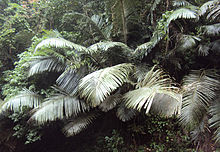Arenga wightii is a species of flowering plant in the family Arecaceae.[2][3] It is native to the Southern Western Ghats in Kerala in India. This palm has various uses in its communities. Local tribal communities depend on this plant for starch (food supplement) and religious ceremonies. It is also used to cover the roofs of houses due to its string resemblance to coconut leaves. Scientists have discovered that this palm has medicinal value. It is said to have antimicrobial and antioxidant phytochemicals. It is threatened by habitat loss.
| Arenga wightii | |
|---|---|

| |
| Arenga wightii at Periya, Wayanad | |
| Scientific classification | |
| Kingdom: | Plantae |
| Clade: | Tracheophytes |
| Clade: | Angiosperms |
| Clade: | Monocots |
| Clade: | Commelinids |
| Order: | Arecales |
| Family: | Arecaceae |
| Genus: | Arenga |
| Species: | A. wightii
|
| Binomial name | |
| Arenga wightii | |
| Synonyms[2] | |
| |
Description
editThis is a pinnately compound leaved palm, with 4-8 meter long leaves. Number of leaflets are usually more than 50 pairs. The leaf surface is glaucous on the underside, with an apex that is unequally two-lobed. The leaf base is asymmetrical, with one of the lobes often extending over the rachis. The tree produces cream colored unisexual flowers, where male and female flowers will be on different inflorescences. Fruits are green and globose.[4]
Ecology
editThis is a plant frequently seen in the steep slopes of Western Ghats, from Uttara Kannada to Kanyakumari. The elevation ranges from 400 m to 800 m.[4] This is a shade loving palm that grows up to a height of 10 m and diameter up to 30 cm and usually seen as colonies.[5]
Uses
editLocal tribal communities, such as the Mudhuvans in Idukki, rely on this palm primarily for the starch obtained from its pith and for toddy, which is collected by tapping its inflorescence. The inflorescence of the palm is used in religious ceremonies, while its leaves, resembling those of the coconut palm, are used for thatching huts and pandals within the settlement.[6] Although the fruit contains needle-like oxalate crystals that cause irritation, it is dehusked and repeatedly boiled to make it suitable for consumption. The dried kernels are ground into a powder and mixed with rice flour to prepare various foods. The palm’s terminal bud, also known as the "cabbage," is edible, though it is rarely used by the community today.[7]
Starch is harvested from the stem of the palm when it reaches an age of 15–20 years. This process involves felling the tree and removing its sclerenchymatous hypodermis. The cylindrical cortex is then chopped, and the starch is extracted by mixing it with water, followed by drying. The dried starch serves as a food supplement and is also used in the preparation of traditional dishes like kurukk and upuma.[7]
Threats
editThe destructive utilization of these palms along its distributional range can be a potential threat for this vulnerable palm species
References
edit- ^ Johnson, D. (1998). "Arenga wightii". IUCN Red List of Threatened Species. 1998: e.T38191A10100189. doi:10.2305/IUCN.UK.1998.RLTS.T38191A10100189.en. Retrieved 17 November 2021.
- ^ a b "Arenga wightii Griff". Plants of the World Online. The Trustees of the Royal Botanic Gardens, Kew. n.d. Retrieved May 11, 2024.
- ^ "Arenga wightii Griff". Catalogue of Life. Species 2000. n.d. Retrieved May 11, 2024.
- ^ a b Page, Navendu (2017). Endemic Woody Plants of the Western Ghats. Trail Blazer Printers and Publishers. ISBN 978-93-5279-072-2.
- ^ Renuka C. Kfri Palmetum. Kfri Research Report No; 2008.
- ^ Asha, V. V., & Pushpangadan, P. Hepatoprotective plants used by the tribals of wynadu, malappuram and palghat districts of Kerala, India. Ancient science of life. 2002; 22.1: 1-8.
- ^ a b Pillai, Arun R.; Riyas, C.T.; Sabu, K. K. (2021-01-05). "A review on the unexplored and underutilized Arenga species in India". Current Botany: 226–232. doi:10.25081/cb.2020.v11.6252. ISSN 2220-4822.
RIYAS Chakkinga Thodi, (2020),A review on the unexplored and underutilized Arenga species in India
External links
edit- [1]
- http://www.palmpedia.net/wiki/Arenga_wightii
- http://www.biotik.org/india/species/a/arenwigh/arenwigh_en.html
